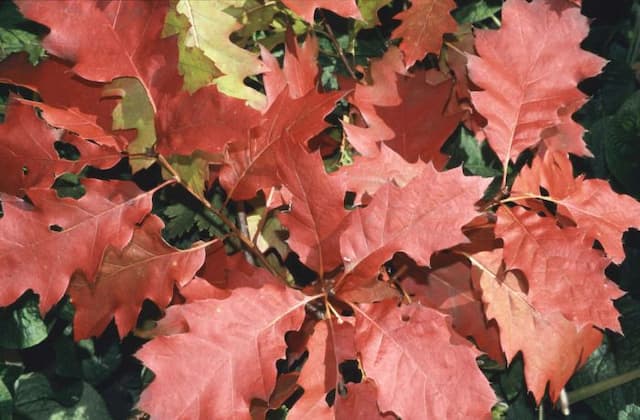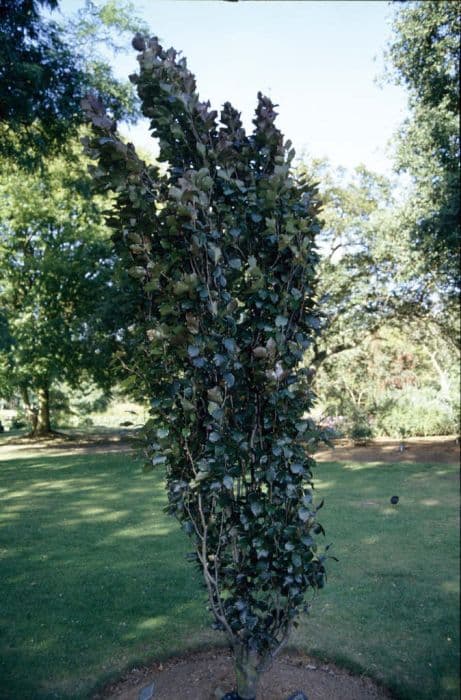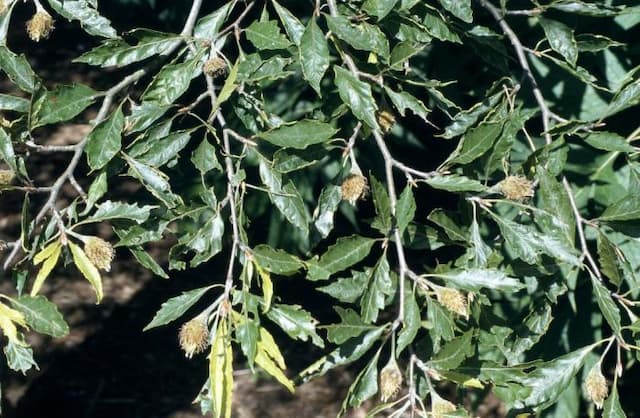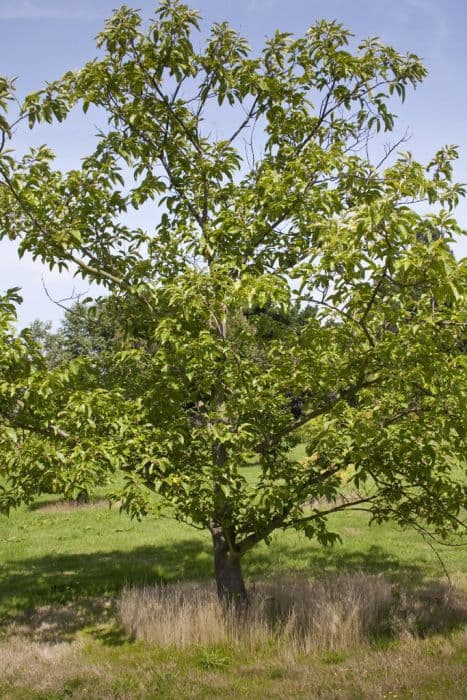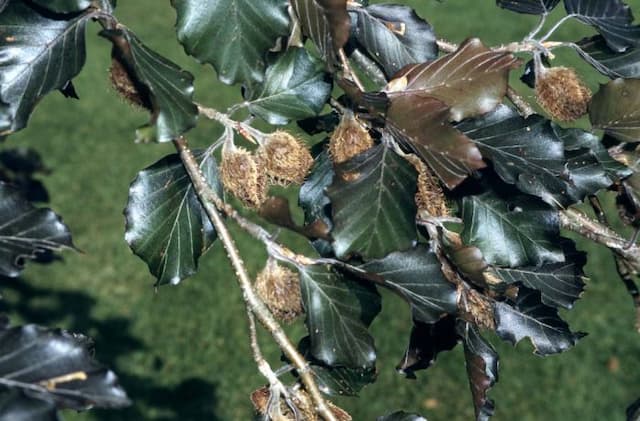Quercus coccinea

ABOUT
The plant commonly known as the scarlet oak is a visually striking species renowned for its vivid autumn colors. It has a rounded to irregular crown, with branches extending outward to form a broad, spreading canopy. The leaves are one of its most distinctive features, with deep lobes and a glossy green color that transforms into a rich scarlet red in the fall season. These leaves are pointed at the tips and have a bristle-like appearance at the lobe ends, creating an almost star-shaped outline. Flowers of the scarlet oak are less noticeable, with the male flowers forming drooping clusters called catkins, while the female flowers are less conspicuous, small, and found alone or in pairs. Following the flowering period, this plant produces acorns, which are a food source for wildlife. The acorns are encased in a scaly cup and take on a broad, rounded shape, maturing to a deep brown when ripe. The bark of the scarlet oak is smooth and gray when young, but as the plant matures, the bark develops ridges and deep furrows, becoming quite rough to the touch. The overall appearance of the scarlet oak during different seasons can significantly vary due to its foliage and fruit, making it a dynamic and attractive element in the landscapes where it is found.
About this plant
 Names
NamesFamily
Fagaceae.
Synonyms
Scarlet Oak, Red Oak, Black Oak, Spanish Oak.
Common names
Erythrobalanus coccinea, Quercus coccinea var. tuberculata
 Toxicity
ToxicityTo humans
The Quercus coccinea is commonly known as the scarlet oak. This tree is not considered highly toxic to humans. However, the acorns and leaves, especially when wilted, contain tannins which can be harmful if ingested in large quantities. Eating significant amounts of this plant material may lead to stomach upset, kidney damage, or in severe cases, poisoning. The symptoms of tannin poisoning include nausea, vomiting, diarrhea, abdominal pain, and potentially kidney failure over time with continuous consumption.
To pets
The scarlet oak is known to be toxic to pets, particularly dogs, cats, and horses, if they consume the leaves or acorns in large amounts. These plant parts contain tannins that can cause gastrointestinal distress and symptoms of poisoning, which include vomiting, diarrhea, abdominal pain, and lack of appetite. In extreme cases, particularly with horses, it can lead to kidney damage and dehydration. Care should be taken to prevent pets from ingesting parts of the scarlet oak tree.
 Characteristics
CharacteristicsLife cycle
Perennials
Foliage type
Deciduous
Color of leaves
Green
Height
50-75 feet (15-23 meters)
Spread
50-60 feet (15-18 meters)
Plant type
Tree
Hardiness zones
4-9
Native area
Eastern North America
Benefits
 General Benefits
General Benefits- Wildlife Habitat: Quercus coccinea, commonly known as the Scarlet Oak, provides habitat and nesting sites for various bird species and other wildlife.
- Food Source: Its acorns are a food source for many animals, such as birds, squirrels, and deer.
- Shade and Shelter: The Scarlet Oak offers shade and shelter for people and wildlife, making it a valuable tree for urban and suburban landscapes.
- Erosion Control: The extensive root system of the Scarlet Oak helps to stabilize soil and prevent erosion.
- Aesthetic Appeal: With its striking red fall foliage, the Scarlet Oak adds significant aesthetic value to parks and residential areas.
- Carbon Sequestration: Like all trees, the Scarlet Oak plays a role in sequestering carbon dioxide, thus contributing to the reduction of greenhouse gases.
- Hardwood Production: The Scarlet Oak is a source of strong, durable hardwood that can be used for furniture, flooring, and timber.
- Soil Improvement: As leaves and acorns decompose, they enrich the soil with organic matter, improving soil quality and fertility.
- Cultural Significance: The Scarlet Oak holds cultural significance in certain regions and can be part of historical landscapes and heritage sites.
- Education and Research: As a native species, the Scarlet Oak can be used for educational purposes and ecological research, fostering a better understanding of deciduous forest ecosystems.
 Medical Properties
Medical PropertiesThis plant is not used for medical purposes.
 Air-purifying Qualities
Air-purifying QualitiesThis plant is not specifically known for air purifying qualities.
 Other Uses
Other Uses- The Scarlet Oak's bark has been historically used for tanning leather due to the tannins it contains.
- The acorns from the Scarlet Oak can be ground into a flour after leaching, and used as a base for soups or a grain substitute.
- Woodworkers value Scarlet Oak wood for furniture-making because of its appealing grain and durability.
- In landscaping, Scarlet Oak is used to add vibrant fall color, as it turns a distinctive red hue in autumn.
- The tree provides valuable habitat and shelter for wildlife, including birds and squirrels.
- Scarlet Oak is sometimes planted as a memorial tree due to its longevity and stately appearance.
- The wood of the Scarlet Oak is used in cooperage, particularly for barrels and casks needing strength.
- Dye extracted from the bark and leaves can be used in textile coloring, giving fabrics a subtle brown hue.
- Scarlet Oak leaves are sometimes used in decorative crafts, such as pressed leaf art due to their distinct shape.
- Because of its resistance to wind and soil compaction, Scarlet Oak is often used in urban planning as a street tree.
Interesting Facts
 Feng Shui
Feng ShuiThe Scarlet Oak is not used in Feng Shui practice.
 Zodiac Sign Compitability
Zodiac Sign CompitabilityThe Scarlet Oak is not used in astrology practice.
 Plant Symbolism
Plant Symbolism- Strength: The Quercus coccinea, commonly known as the Scarlet Oak, is part of the oak tree family which has long been symbolic of strength due to their hard and sturdy wood.
- Endurance: Oak trees are known for their longevity and ability to withstand harsh conditions, making them representative of endurance.
- Wisdom: Oaks, as ancient beings, have been revered as a source of wisdom and are often associated with knowledge.
- Nobility: Throughout history, the oak has been a symbol of nobility and has often been associated with kings and gods.
- Hospitality: In some cultures, the oak tree is seen as a symbol of hospitality due to its large and welcoming canopy.
- Stability: The solid and unwavering nature of the oak tree lends itself as a symbol for stability and reliability.
 Water
WaterScarlet Oak trees require deep watering, which is best done by allowing a slow trickle of water to soak into the soil around the root zone, avoiding shallow sprinklings. Young trees especially benefit from weekly watering with about 15-20 gallons during dry spells. Mature trees, however, have a deep root system and typically require less frequent watering unless there are extreme drought conditions. During the growing season, ensure the soil is moist but not waterlogged. In winter, reduce the frequency of watering as the tree's growth and water requirements slow down.
 Light
LightScarlet Oaks thrive in full sunlight, needing at least six hours of direct, unfiltered sunlight each day. The ideal spot is an open area away from larger structures or trees that could cast shade, as this tree species does best with ample sun exposure to develop its foliage and structure properly.
 Temperature
TemperatureScarlet Oaks are hardy trees that can withstand a range of temperatures; they do best in temperatures ranging from 20 to 90 degrees Fahrenheit. They can survive winter lows down to -20°F, which makes them suitable for various climates. Optimal growth occurs in temperate conditions within the ideal temperature range.
 Pruning
PruningPruning Scarlet Oaks is generally conducted to remove dead or broken branches, to shape the tree for better structure, or to clear away low-hanging limbs for clearance. The best time for pruning is in the dormant season, typically late fall to winter, to minimize sap loss and potential disease entry. Pruning should be carried out as needed, but not excessively, as oaks can be sensitive to over-pruning.
 Cleaning
CleaningNot needed
 Soil
SoilThe Scarlet Oak (Quercus coccinea) thrives in well-drained acidic soil with a pH of 4.5 to 6.5. A good soil mix for this tree would be a combination of loamy soil, compost, and perlite or sand to improve drainage. Organic matter like leaf mold can also be beneficial to mimic the forest floor conditions they naturally prefer.
 Repotting
RepottingThe Scarlet Oak (Quercus coccinea) is a large tree and is not typically grown in conditions where repotting is necessary or practical. In its early years, it may be transplanted if grown in a nursery setting, but once established in the landscape, it should not need repotting.
 Humidity & Misting
Humidity & MistingScarlet Oak (Quercus coccinea) is adaptable to a wide range of outdoor humidity levels and does not require specific humidity conditions for growth, as it is tolerant of both dry and humid climates.
 Suitable locations
Suitable locationsIndoor
Not suitable for indoor growth, needs outdoor space.
Outdoor
Plant in full sun, well-draining soil, ample space for growth.
Hardiness zone
4-9 USDA
 Life cycle
Life cycleThe life cycle of Quercus coccinea, commonly known as the Scarlet Oak, begins with acorn germination which typically occurs in the spring following dispersal. The seedling stage follows, characterized by the emergence of a radicle and plumule which will develop into the root system and shoots respectively. As the tree enters the sapling stage, it develops a sturdy stem, branching structure, and leaf canopy necessary for photosynthesis and continued growth. Upon reaching maturity, the Scarlet Oak produces flowers, with male catkins and female flowers on the same tree, leading to pollination and acorn production. These acorns, once matured, are dispersed by gravity, animals, or other vectors to new locations where they can potentially germinate and begin a new cycle. The Scarlet Oak can live several hundred years, continuing the cycle of growth and reproduction throughout its lifetime.
 Propogation
PropogationPropogation time
Fall to early spring
The most popular method of propagating the Scarlet Oak, Quercus coccinea, is through its acorns. Ideal propagation time is in autumn, as soon as the acorns drop from the tree. To propagate, collect healthy acorns and plant them directly in well-draining soil at a depth of approximately 1 to 2 inches (2.5 to 5 centimeters). The acorns require a period of cold stratification to break dormancy, which occurs naturally when they are sown outdoors in fall. Alternatively, if planting is delayed until spring, acorns must be artificially stratified by storing them in a plastic bag with moist sand or peat moss in a refrigerator for 2 to 3 months at temperatures around 33 to 41 degrees Fahrenheit (0.5 to 5 degrees Celsius). Once sown, keep the soil moist but not waterlogged and expect germination in the following spring. This simple approach closely mimics the natural process of acorn germination in the wild.

